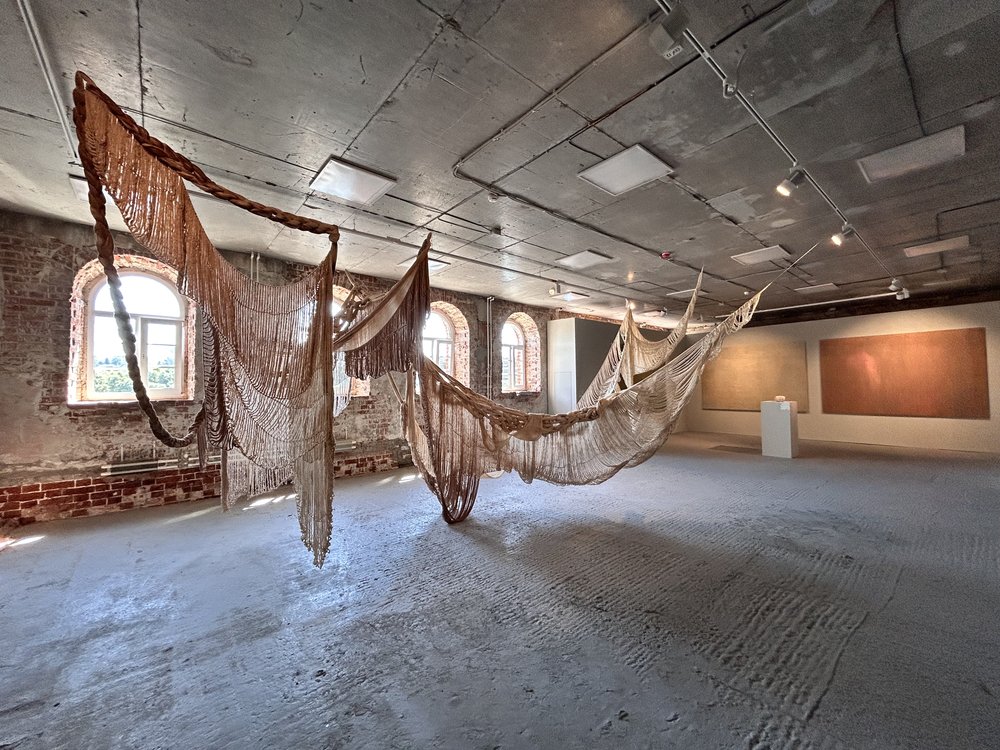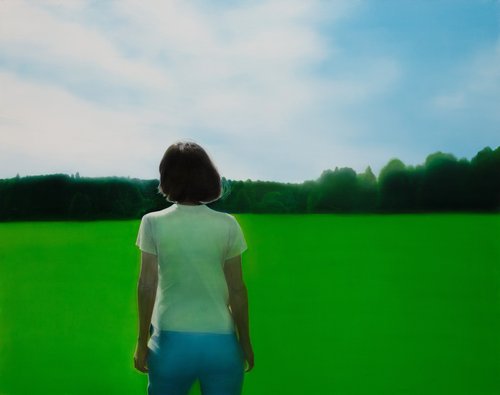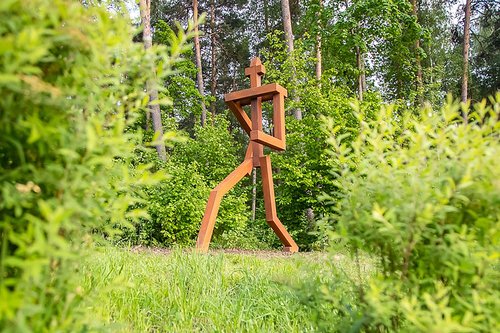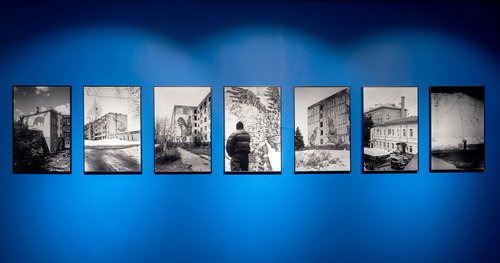A New Biennale in Nizhny Novgorod Seeks to Promote Eco-Awareness

Skin of the Earth. International Biennale of Environmental Art. Exhibition view. Nizhny Novgorod, 2025. Photo by Julia Korotkova
The First International Biennale of Environmental Art has opened to the public in the Russian city of Nizhny Novgorod. Spread over several locations throughout this historical city turned contemporary art hub, the event has attracted artists from all over the world.
Nizhny Novgorod, a historical city on the Volga River, is today reinventing itself as a city of the contemporary arts. Seen as the nation’s capital of street art, there is a fast-evolving local art scene, from major state art museums showing contemporary art to independent galleries and artist-run spaces; and Contour art fair dedicated to works on paper and photography.
This year, Nizhny Novgorod finally has its own biennale – the first International Biennale of Environmental Art, an intense dive into the ecological agenda. An ambitious initiative of the Nizhny Novgorod regional Government – one of the largest industrial centres in Russia – its goal is to establish ecology as a unifying theme in contemporary cultural discourse in our fragmented world and encourage the public to reflect on the delicate and ever more complex relationship between humanity and nature. The Triumph Gallery from Moscow is one of the co-organisers of the biennale, responsible for the overall curation of the event, with Yulia Aksenova serving as chief curator and program director. Such a niche collaboration between the state and private sector can only be mutually beneficial: Nizhny Novgorod gets an influx of international art and positive media coverage while the artists shown by the galleries can add “biennale” in their portfolio.
Another goal of the biennale is to show that even during this period of cultural isolation, there are many countries who are still willing to collaborate with Russian in the field of the arts, especially when it comes to ecology, a subject which is considered both neutral and safe. There are artists from Argentina, China, Mexico, Saudi Arabia, India, Colombia, Vietnam, Zimbabwe, the Republic of Korea, Nepal, Nigeria, Peru, Senegal, the Philippines, and Singapore, among others and perhaps surprisingly, a small contingency even from countries officially declared ‘unfriendly’ by Russian authorities such as the USA, United Kingdom, France, Italy, Austria, and Japan. Many come from countries with a colonial past which in Russia brings attention to a host of issues which are often unfamiliar, expanding the exhibition narrative. To some this might feel like an artifical addition, for others it broadens their understanding of the environmental agenda.
The biennale is spread out across diverse venues throughout the city from the major Volga-Vyatka branch of the Pushkin State Museum of Fine Arts (Arsenal) and the Nizhny Novgorod State Art Museum to historical buildings of the Mytny Market and Ermolaev Hotel that host the main exhibition project of the biennale called ‘The Skin of the Earth’.
‘The Skin of the Earth’ explores the Earth's thin outer layer, likening it to skin reminding us of its vital importance to the planet. The artists in this comprehensive two-part exhibition all delve deeply into the notion of “memory of soils” focussing on the repercussion of human intervention in our environment. The bright and airy interior of the former Mytny Market, with its green roof and rays of light piercing the main hall, evokes an ambiance full of nature which one can reflect in silent meditation while looking at ‘Forest’ paintings by Elena Filaretova (b. 1995), walk through Ilya Sibiryakov’s ‘Portal’ installation which resembles a spider web or a cell structure, or take a look at a forest ecosystem in ‘Everything the Forest Remembers’ by Robert Zhao Renhui (b. 1983). Prominent works like ‘Cultural Layer’ by Recycle Group, ‘Wild Fire’ by Olanrewaju Tejuoso from Nigeria, or Ghanaian artist Serge Attukwei Clottey’s (b. 1985) ‘Better Late than Never’ serve as eloquent and alarming messages regarding humanity’s detrimental impact on the planet.
The second part of ‘The Skin of the Earth’ is housed in the four-story historical Ermolaev hotal, constructed in 1896 by renowned Nizhny Novgorod merchant Fyodor Ermolaev. Compared with the Mytny Market, this exhibition has a mystical atmosphere and metaphysical vibe. Many of the works of art on display explore traditional rituals and beliefs about nature, like ‘Daily Attire of Priest-Sheaves’ by Sergey Sonin (b. 1968) and Elena Samorodova (b. 1973), and documentation of the performance ‘Stepa Hidra’ by Ulyana Podkorytova (b. 1984). There are a lot of works which border between reality and fantasy with visual and formal mutations and curious transformations using strange media and with disturbing creatures by artists like Sasha Nesterkina (b. 1990), Alexey Buldakov (b. 1980), the Ho Gui artist duo, Ivan Gorshkov (b. 1986) and Alexey Kallima (b. 1969).
The Volga-Vyatka branch of the Pushkin State Museum of Fine Arts (Arsenal) located in the Kremlin, hosts an exhibition called ‘Terrestrial/Planetary’. It opens with ‘Seascape’ a large installation by Korean artist Kim Soon-im (b. 1975) composed out of found pieces of rubbish which are strung from cotton threads which practically force visitors to immerse themselves inside layers of waste - thus confronting its pervasive presence. An eye-catching backdrop for museum selfies, perhaps it will also encourage visitors to think about our planet.
One of the most unforgettable and aesthetically striking projects in the Biennale is ‘Digital Aspirations’ which brings together multimedia artists who show us the inevitability and irreversibility of many natural processes yet also offer hope that we can discover a fragile peace and unity with our planet Earth. ‘Artificial Wild Dream’ by Ronen Tanchum (b. 1987) explores a machine’s perception of the organic world; ‘Abyssal Seeker’ by British artist Joey Holder (b. 1986) imagines parallel, alternative models for the development of life on Earth. And the installation ‘Point of Singularity’ by Moscow’s Sila Sveta studio, visualises the origin of the universe inside a 360° led sphere, an experience where you feel more unity with planet earth than when looking at countless more traditional works of art across the biennale.
Reflecting on the environmental crisis today, you might ask yourself whether the world needs another biennale. The kind of production behind such an event is hardly sustainable, and the logistics of works of art and participating artists and professionals inevitably increase the carbon footprint. While it is a worthy goal to raise public awareness of such a challenging topic through art, there is a sense that now such actions may be more pressing than simple conversations. Ultimately, the biennale offers a romanticized poetic statement about the real issues rather than actively provoking problem-solving.
The writer’s trip to Nizhny Novgorod was organized by the press office of the International Biennale of Environmental Art.
International Biennale of Environmental Art
Nizhny Novgorod, Russia
30 May – 1 October 2025


















